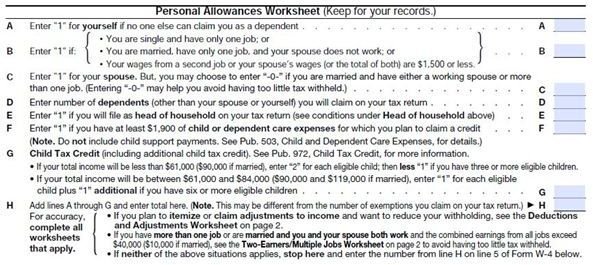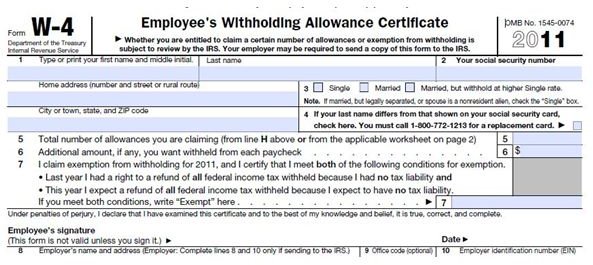Learn How Do I Figure Out How Many Exemptions Should I Claim on the W-4 Form
A Case Study of the W-4
The W-4 form is an Internal Revenue Service (IRS) form and as with most IRS forms people can get confused on how to complete them. Before I answer the question, how many exemptions should I claim on a W-4 form, don’t let the following happen to you, you’ll end up owing the IRS.
Case Study – My niece recently started a new job working as a receptionist at a hospital. Unsure of how to fill out her W-4, she asked the Human Resources (HR) department and was told she could just click the “exempt” from withholding tax if she wanted. This is a bad idea and no one should check the exempt box unless they expect to make less than $900 annually—obviously my niece made way more than that and when tax time came, because she clicked the exempt from taxes box, she owed the IRS more than $1,500. Of course she didn’t have $1,500 and was forced to implement an IRS payment plan and that means a tax lien on personal assets (home) owned until paid in full and a tax lien will appear on your credit report.
This is the sign of a bad HR department, so it’s important to read the instructions on the W-4 form to help you determine how many dependents can you claim for a payroll deduction.
Read the Directions
As a business owner with an HR degree, I have often seen employees turn in W-4 forms with either the exempt from withholding box checked or they will claim dependent deductions of 7 or more, meaning less federal withholding tax is taken out of every paycheck. I always question if they have completed the worksheet on the top of the W-4 (you can download a sample W-4 form here).
Most of the time, they have not completed the worksheet and were directed by a friend or family member to claim as many deductions as possible and then at tax time, they are hit with owing the IRS, especially if their wages are on the higher end of the scale.
In some cases, if you meet all the deduction requirements it is fine to claim a high amount, but that worksheet is there for a reason—to help you determine the right deductions to claim.
What Should You Claim on the W-4?

Let’s take a look at the worksheet to help you determine the correct amount you should claim on your W-4. On the sample W-4 you downloaded from our Media Gallery, you can see there are questions A through G.
Question A – Here you enter a 1 for yourself if no one else claims you as a dependent. It’s best to enter a 1 here.
Question B – This question is a little confusing. It allows you to enter a 1 if:
- You are single and only have one job
- You are married and have one job and your spouse doesn’t work
- You wages from your second job “or” the wages of your spouse’s job are less than $1,500.
This is where people start making errors because they feel they fit into one of these 3 categories. Leave this blank or place a zero in this box.
Question C – Enter a 1 for your spouse “or” if your spouse works you might want to enter a zero to avoid having pay at tax time. If you are married and your spouse works, I suggest entering a 1.
Question D – Enter dependents other than yourself (not spouse) that you will claim on your tax return. Often people totally miss the “not spouse” part of this question and add up all their children and include the spouse. Only enter the number of dependents that are not your spouse.
Question E – Enter a 1 if you are filing as head of household. If you are married you can’t claim head of household. You can only do this if you are unmarried and have at least one dependent.
Question F – Enter a 1 if you have $1,900 of child expenses you plan on including in your tax return (this doesn’t include child support). Here again, unless you plan on itemizing child expenses, leave this zero.
Question G – Child Tax Credit – Again, unless you plan to itemize child expenses to obtain a tax credit, you should leave this at zero.
From the above, you can see that I have entered a 1 for questions A and C. If I had 2 children, I would enter a 2 in Question D for dependents so my total deductions on my W-4 form would be 4. That amount is carried to the bottom portion of your W-4.
Please continue on to Page 2 for more information on how many dependents can you claim for a payroll deduction.
Additional Ways to Complete a W-4 Form

Tax specialist Jason Guthrie suggests an even easier way to answer how many deductions should I claim on a W-4 tax form? He offers that you should look at your prior year’s tax return and use his online calculator to estimate the current year’s income.
The second step Guthrie suggests is one you’ve calculated estimate income, use his W-4 calculator to determine the true amount of deductions to claim so you owe the IRS zero at year end and they owe you zero. You can find a link to Mr. Guthrie’s article here.
Things to Keep In Mind

As an employer, when I do receive those W-4 forms that show a low number of exemptions claimed (say zero) and I know the employee is married and has 4 dependents, I often ask, why are you claiming zero exemptions? Of course their answer is, “So the IRS will give me a great, big, fat refund at tax time!”
Let’s think about this honestly. The lower number you insert on your W-4, the more federal taxes will be taken out (some states also utilize what you fill out on your W-4 to determine state taxes withheld). If you’re making a salary of around $40,000 per year and have 3 dependents and you claim zero, you’ll have a load of federal, and maybe state taxes taken out of each paycheck and yes you will most likely get all that back when April 15th rolls around.
On the other side of that coin, what if you opened up a savings account that offered interest on top of what you put in the savings account? You would be gaining interest on money you are having withheld from your paycheck and Uncle Sam does not pay you interest, so what you put in, you’ll get back—without interest.
While this may take some planning on your part to ensure you put money into your savings account, earning interest is better than just using Uncle Sam as a no-interest savings account every year. Some companies that utilize direct deposit for employee paychecks will even allow you to deposit a certain amount into checking and a certain amount into savings—so ask if your company offers this feature.
In the end, it’s best not to use the IRS as a no-interest savings account. On the other hand if you have many dependents, you may want to take all the exemptions you can, however, beware, if you don’t plan to itemize, skip the exemptions that require itemization on your annual tax return and leave them at zero.
When considering how many exemptions should I claim on a W-4 form, the higher amount of dependents or exemptions, the less federal tax withheld and the lower the dependents or exemptions the higher the federal (or state) tax withheld.
Finally, you can always request to change your W-4 form if you feel you’ve calculated your exemptions incorrectly; just ask your personnel department.
References
Guthrie, Jason – How Many Deductions to Take on W-4, (March 2007) retrieved at https://beancounterblog.com/2007/03/06/how-many-deductions-to-take-on-your-w-4/
Internal Revenue Serive - https://www.irs.gov
Image Credits:
IRS Logo - Wikimedia Commons/US Dept of the Treasury
Screenshots of W-4 by author courtesy of IRS
Uncle Sam - Wikimedia Commons Share A-Like
